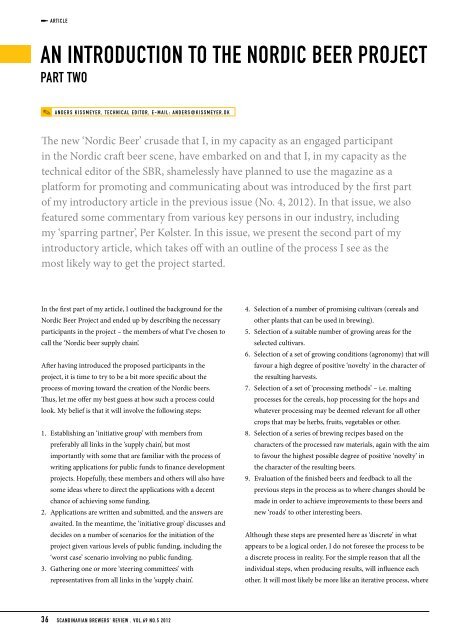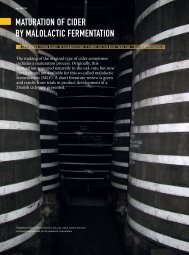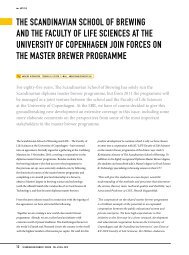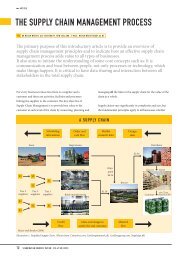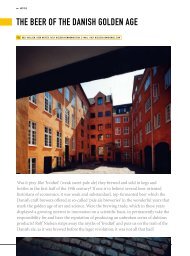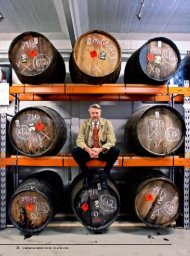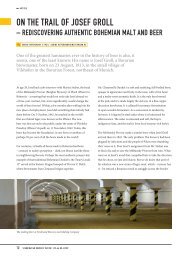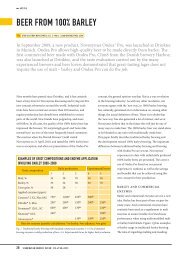An Introduction to the Nordic Beer Project – Part ... - Scandbrewrev.dk
An Introduction to the Nordic Beer Project – Part ... - Scandbrewrev.dk
An Introduction to the Nordic Beer Project – Part ... - Scandbrewrev.dk
You also want an ePaper? Increase the reach of your titles
YUMPU automatically turns print PDFs into web optimized ePapers that Google loves.
article<br />
<strong>An</strong> <strong>Introduction</strong> <strong>to</strong> <strong>the</strong> <strong>Nordic</strong> <strong>Beer</strong> <strong>Project</strong><br />
<strong>Part</strong> two<br />
<strong>An</strong>ders Kissmeyer, technical edi<strong>to</strong>r, e-mail: anders@kissmeyer.<strong>dk</strong><br />
The new ‘<strong>Nordic</strong> <strong>Beer</strong>’ crusade that I, in my capacity as an engaged participant<br />
in <strong>the</strong> <strong>Nordic</strong> craft beer scene, have embarked on and that I, in my capacity as <strong>the</strong><br />
technical edi<strong>to</strong>r of <strong>the</strong> SBR, shamelessly have planned <strong>to</strong> use <strong>the</strong> magazine as a<br />
platform for promoting and communicating about was introduced by <strong>the</strong> first part<br />
of my introduc<strong>to</strong>ry article in <strong>the</strong> previous issue (No. 4, 2012). In that issue, we also<br />
featured some commentary from various key persons in our industry, including<br />
my ‘sparring partner’, Per Kølster. In this issue, we present <strong>the</strong> second part of my<br />
introduc<strong>to</strong>ry article, which takes off with an outline of <strong>the</strong> process I see as <strong>the</strong><br />
most likely way <strong>to</strong> get <strong>the</strong> project started.<br />
In <strong>the</strong> first part of my article, I outlined <strong>the</strong> background for <strong>the</strong><br />
<strong>Nordic</strong> <strong>Beer</strong> <strong>Project</strong> and ended up by describing <strong>the</strong> necessary<br />
participants in <strong>the</strong> project <strong>–</strong> <strong>the</strong> members of what I’ve chosen <strong>to</strong><br />
call <strong>the</strong> ‘<strong>Nordic</strong> beer supply chain’.<br />
After having introduced <strong>the</strong> proposed participants in <strong>the</strong><br />
project, it is time <strong>to</strong> try <strong>to</strong> be a bit more specific about <strong>the</strong><br />
process of moving <strong>to</strong>ward <strong>the</strong> creation of <strong>the</strong> <strong>Nordic</strong> beers.<br />
Thus, let me offer my best guess at how such a process could<br />
look. My belief is that it will involve <strong>the</strong> following steps:<br />
1. Establishing an ‘initiative group’ with members from<br />
preferably all links in <strong>the</strong> ‘supply chain’, but most<br />
importantly with some that are familiar with <strong>the</strong> process of<br />
writing applications for public funds <strong>to</strong> finance development<br />
projects. Hopefully, <strong>the</strong>se members and o<strong>the</strong>rs will also have<br />
some ideas where <strong>to</strong> direct <strong>the</strong> applications with a decent<br />
chance of achieving some funding.<br />
2. Applications are written and submitted, and <strong>the</strong> answers are<br />
awaited. In <strong>the</strong> meantime, <strong>the</strong> ‘initiative group’ discusses and<br />
decides on a number of scenarios for <strong>the</strong> initiation of <strong>the</strong><br />
project given various levels of public funding, including <strong>the</strong><br />
‘worst case’ scenario involving no public funding.<br />
3. Ga<strong>the</strong>ring one or more ‘steering committees’ with<br />
representatives from all links in <strong>the</strong> ‘supply chain’.<br />
4. Selection of a number of promising cultivars (cereals and<br />
o<strong>the</strong>r plants that can be used in brewing).<br />
5. Selection of a suitable number of growing areas for <strong>the</strong><br />
selected cultivars.<br />
6. Selection of a set of growing conditions (agronomy) that will<br />
favour a high degree of positive ‘novelty’ in <strong>the</strong> character of<br />
<strong>the</strong> resulting harvests.<br />
7. Selection of a set of ‘processing methods’ <strong>–</strong> i.e. malting<br />
processes for <strong>the</strong> cereals, hop processing for <strong>the</strong> hops and<br />
whatever processing may be deemed relevant for all o<strong>the</strong>r<br />
crops that may be herbs, fruits, vegetables or o<strong>the</strong>r.<br />
8. Selection of a series of brewing recipes based on <strong>the</strong><br />
characters of <strong>the</strong> processed raw materials, again with <strong>the</strong> aim<br />
<strong>to</strong> favour <strong>the</strong> highest possible degree of positive ‘novelty’ in<br />
<strong>the</strong> character of <strong>the</strong> resulting beers.<br />
9. Evaluation of <strong>the</strong> finished beers and feedback <strong>to</strong> all <strong>the</strong><br />
previous steps in <strong>the</strong> process as <strong>to</strong> where changes should be<br />
made in order <strong>to</strong> achieve improvements <strong>to</strong> <strong>the</strong>se beers and<br />
new ‘roads’ <strong>to</strong> o<strong>the</strong>r interesting beers.<br />
Although <strong>the</strong>se steps are presented here as ‘discrete’ in what<br />
appears <strong>to</strong> be a logical order, I do not foresee <strong>the</strong> process <strong>to</strong> be<br />
a discrete process in reality. For <strong>the</strong> simple reason that all <strong>the</strong><br />
individual steps, when producing results, will influence each<br />
o<strong>the</strong>r. It will most likely be more like an iterative process, where<br />
36 SCANDINAVIAN BREWERS’ REVIEW . VOL.69 NO.5 2012
<strong>An</strong> <strong>Introduction</strong> <strong>to</strong> <strong>the</strong> <strong>Nordic</strong> <strong>Beer</strong> <strong>Project</strong><br />
feedback from each step will have implications on one or more<br />
of <strong>the</strong> o<strong>the</strong>rs <strong>–</strong> back and forth in an unforeseeable pattern <strong>–</strong><br />
unpredictable, I would expect, even far in<strong>to</strong> <strong>the</strong> process.<br />
The Selection Processes<br />
The term ‘selection’ is used in connection with most of <strong>the</strong><br />
steps in <strong>the</strong> process. All selection processes have <strong>to</strong> be based on<br />
selection criteria, so it is reasonable <strong>to</strong> ask what criteria <strong>the</strong>se<br />
selection processes should be based on. In ‘normal’ projects,<br />
<strong>the</strong> choice of criteria and methods for selection would be<br />
based on a systematic approach: Which parameters should <strong>the</strong><br />
selection criteria be defined by, how can <strong>the</strong>se be quantified<br />
and measured and what acceptance limits should define <strong>the</strong><br />
success criteria? But this approach is, unfortunately, futile in<br />
<strong>the</strong> context of this project, as it involves moving in<strong>to</strong> <strong>to</strong>tally<br />
unchartered waters. If we, for instance, logically and reasonably<br />
start by demanding that <strong>the</strong> selection of cultivars must based<br />
on <strong>the</strong> positive aroma, flavour and taste attributes <strong>the</strong>se give<br />
<strong>to</strong> <strong>the</strong> finished beer, we will bump our heads against <strong>the</strong> wall<br />
immediately. Simply because any positive attributes found in<br />
<strong>the</strong> finished beer can come from numerous sources. Apart from<br />
<strong>the</strong> cultivar itself, <strong>the</strong>y may be due <strong>to</strong> <strong>the</strong> growing location and<br />
conditions for <strong>the</strong> cultivars, <strong>the</strong> choice of processing methods<br />
for <strong>the</strong> crops and any aspect of <strong>the</strong> brewing process. <strong>An</strong>d<br />
fur<strong>the</strong>r, even if <strong>the</strong> approach was possible, it would entail an<br />
enormity of options for each individual process steps involved.<br />
<strong>An</strong>d as <strong>the</strong>re are a multitude of process steps from choice<br />
of cultivar <strong>to</strong> finished beer, <strong>the</strong> project would take literally<br />
thousands of years applying this approach.<br />
In my view, <strong>the</strong>re is no alternative <strong>to</strong> <strong>the</strong> ‘intuitive approach’. By<br />
this I mean that all <strong>the</strong> representatives of <strong>the</strong> different members<br />
of <strong>the</strong> supply chain sit down at table and start throwing ideas,<br />
thoughts and experiences at each o<strong>the</strong>r, and <strong>the</strong>n <strong>–</strong> hopefully <strong>–</strong><br />
after an open and engaged discussion, a unanimity concerning<br />
a number of promising ‘routes’ for <strong>the</strong> initial trials may be<br />
chosen, eliminating at least 99.9 per cent of <strong>the</strong> o<strong>the</strong>r possible<br />
‘routes’.<br />
The <strong>Nordic</strong> <strong>Beer</strong> Language<br />
In parallel <strong>to</strong> <strong>the</strong> described process, a common ‘language’ has <strong>to</strong><br />
be developed and refined. This language will, as it evolves, have<br />
<strong>to</strong> enable an ever increasing precision in <strong>the</strong> feedback between<br />
<strong>the</strong> steps in <strong>the</strong> process through <strong>the</strong> people involved in <strong>the</strong>se.<br />
Gradually, as <strong>the</strong> project progresses, it must meet <strong>the</strong> goal <strong>to</strong><br />
move away from <strong>the</strong> initial, intuitive approach <strong>to</strong> what routes<br />
<strong>to</strong> follow in <strong>the</strong> project <strong>to</strong>wards a more scientific approach.<br />
This must imply evaluation of <strong>the</strong> routes chosen based on<br />
objective criteria, developed from knowledge acquired through<br />
<strong>the</strong> project about what is good and what is bad. Good in this<br />
SCANDINAVIAN BREWERS’ REVIEW . VOL.69 NO.5 2012 37
<strong>An</strong> <strong>Introduction</strong> <strong>to</strong> <strong>the</strong> <strong>Nordic</strong> <strong>Beer</strong> <strong>Project</strong><br />
context is what seems promising in regard <strong>to</strong> creating new and<br />
interesting flavours in <strong>the</strong> finished beers, and bad is what seems<br />
<strong>to</strong> create insignificant brewing options. But in order <strong>to</strong> move<br />
in this direction a project specific language must be developed<br />
<strong>–</strong> some of it probably borrowed from existing scientific<br />
vocabularies and some of it probably invented from scratch. If<br />
this seems very hypo<strong>the</strong>tical, I can try <strong>to</strong> exemplify by asking<br />
what words should we use for <strong>the</strong> properties <strong>–</strong> <strong>the</strong> looks, <strong>the</strong><br />
taste and smell and <strong>the</strong> chemical analyses <strong>–</strong> of an old cultivar of<br />
oats in order <strong>to</strong> describe what this does <strong>to</strong> <strong>the</strong> creamy texture<br />
and <strong>the</strong> bisquity and almondy flavour of a <strong>Nordic</strong> pale ale? <strong>An</strong>d<br />
how do we ensure that <strong>the</strong>se words make perfect sense <strong>to</strong> <strong>the</strong><br />
plant breeder developing this oat cultivar and <strong>the</strong> farmer who<br />
is going <strong>to</strong> grow it? The language must give <strong>the</strong>se parties clear<br />
direction in terms of what <strong>the</strong> breeder should look for in <strong>the</strong><br />
biological material, and <strong>the</strong> farmer on how he should look after<br />
his crop of this oat. To me, <strong>the</strong>re is no doubt that <strong>the</strong> project<br />
will entail rejection of a very large percentage of <strong>the</strong> cultivars<br />
and methods tested, and only let very few pass <strong>the</strong> ‘needle’s eye’<br />
in<strong>to</strong> commercial growing and processing stages. Thus, making<br />
sure that <strong>the</strong> right ones are rejected and <strong>the</strong> right ones chosen<br />
requires a very precise set of <strong>to</strong>ols out of which I consider <strong>the</strong><br />
language <strong>the</strong> most essential one, as it is <strong>the</strong> one that is used for<br />
communication all <strong>the</strong> way up and down <strong>the</strong> supply chain.<br />
Even this language will <strong>–</strong> just like <strong>the</strong> actual steps in <strong>the</strong><br />
process <strong>–</strong> also most certainly develop and evolve throughout<br />
<strong>the</strong> project. Eventually, I foresee that it will develop in<strong>to</strong> a<br />
specific set of specifications that may be applied in quantitative<br />
selection criteria. After an even longer time, <strong>the</strong> words <strong>–</strong> if not<br />
all <strong>the</strong>n at least a significant part of <strong>the</strong>m <strong>–</strong> will be translated<br />
in<strong>to</strong> or replaced by analytically measurable, quantitative<br />
parameters. If this sounds abstract, I can say that <strong>the</strong> objective<br />
is <strong>to</strong> establish a communication similar <strong>to</strong> <strong>the</strong> one existing<br />
<strong>to</strong>day between breeders, growers, maltsters and brewers with<br />
<strong>the</strong> aim <strong>to</strong> secure <strong>the</strong> brewers precisely <strong>the</strong> lager malt that <strong>the</strong>y<br />
need. This is precisely <strong>the</strong> type of effective communication that<br />
will develop over time between supplier and cus<strong>to</strong>mer/user, so<br />
this will surely also happen for <strong>the</strong>se novel ingredients.<br />
yielding barley for producing lager malt. <strong>An</strong>d not just that <strong>–</strong> it<br />
also had <strong>to</strong> be malt that gave absolutely no variation in <strong>the</strong><br />
aroma, flavour and taste of <strong>the</strong> beer brewed with it. Commercial<br />
hop growing in our <strong>Nordic</strong> region seized, as <strong>the</strong> only parameter<br />
determining <strong>the</strong> demand for <strong>the</strong> hops was <strong>the</strong> alpha acid<br />
content, and this was a lot higher in Central Europe. Surely,<br />
many of <strong>the</strong> hop varieties previously commercially grown in<br />
our area had a multitude of aromatic characteristics, but <strong>the</strong>se<br />
were all of a sudden <strong>to</strong>tally irrelevant. O<strong>the</strong>r non-traditional<br />
ingredients for brewing <strong>–</strong> herbs, spices, fruits, honeys and nonbarley<br />
cereals <strong>–</strong> were left <strong>to</strong>tally unexplored as <strong>the</strong>y were not of<br />
interest in lager brewing. Aromatic ingredients...what? We don’t<br />
need any such things in our pilsners!<br />
Motivation <strong>to</strong> <strong>Part</strong>icipate<br />
But still, how on earth would it be possible <strong>to</strong> motivate all<br />
<strong>the</strong> institutions and persons in <strong>the</strong> ‘supply chain’ <strong>to</strong> invest<br />
<strong>the</strong>ir time and money in something as ‘fluffy’, risky and<br />
unpredictable <strong>–</strong> <strong>to</strong> put it mildly <strong>–</strong> as <strong>the</strong> <strong>Nordic</strong> <strong>Beer</strong> <strong>Project</strong>?<br />
Well, I actually believe that all <strong>the</strong> members of <strong>the</strong> supply<br />
chain will be so extremely fascinated by <strong>the</strong> entire process <strong>the</strong>y<br />
will embark on that this in itself will be sufficient motivation.<br />
Maybe even <strong>to</strong> <strong>the</strong> extent where <strong>the</strong> chances of a full-blown<br />
success are less important <strong>to</strong> <strong>the</strong>m, as <strong>the</strong>y will realise that <strong>the</strong><br />
knowledge gained from participating easily will be worth <strong>the</strong><br />
investment. The intense networking involved in participating<br />
will necessarily create a wealth of knowledge of what everyone’s<br />
cus<strong>to</strong>mers are asking for and where <strong>the</strong>ir interests in terms<br />
of new materials and processes lie. Also, <strong>the</strong> project will<br />
create new knowledge of what works and what doesn’t in<br />
an entirely new area of business for both <strong>the</strong>mselves and<br />
for <strong>the</strong>ir cus<strong>to</strong>mers, which I’m sure <strong>the</strong>y will see as of great<br />
value <strong>to</strong> <strong>the</strong>m. They will all realise, I think, that <strong>the</strong> opening<br />
of new doors involved with <strong>the</strong> project will entail a very high<br />
probability of ‘spin-offs’ from <strong>the</strong> project itself, and <strong>the</strong>se<br />
may be of significant commercial value <strong>to</strong> <strong>the</strong>m. So, in short,<br />
all participants in <strong>the</strong> <strong>Nordic</strong> <strong>Beer</strong> <strong>Project</strong> will get a unique<br />
opportunity <strong>to</strong> learn a lot of new things about <strong>the</strong>ir markets<br />
and <strong>the</strong>ir cus<strong>to</strong>mers while participating.<br />
Have I <strong>to</strong>tally lost my senses here? If this was such a great idea,<br />
why hasn’t it been established decades or centuries ago? Well,<br />
I actually believe that all <strong>the</strong> readers of <strong>the</strong> SBR in fact know<br />
<strong>the</strong> explanation for this: The ‘curse’ of <strong>the</strong> ‘lager revolution’ that<br />
swept us from <strong>the</strong> late 19th century, and soon meant <strong>the</strong> only<br />
significant beer style world-wide was pale lager beer. From<br />
<strong>the</strong>n on, <strong>the</strong> only objectives of malting barley breeding became<br />
<strong>to</strong> supply <strong>the</strong> highest quality, cheapest, pest resistant and high<br />
Learnings from <strong>the</strong> ‘New <strong>Nordic</strong> Cuisine’<br />
In my piece in an earlier issue (No. 2, 2012) of <strong>the</strong> SBR on<br />
<strong>the</strong> potential for a lucrative establishment of beer <strong>to</strong>urism <strong>to</strong><br />
Scandinavia, I highlighted <strong>the</strong> parallels of <strong>the</strong> <strong>Nordic</strong> craft<br />
brewing scenes <strong>to</strong> <strong>the</strong> ‘New <strong>Nordic</strong> Cuisine’ which is currently<br />
attracting unprecedented attention worldwide. If we cut away<br />
all <strong>the</strong> buzz that is only related <strong>to</strong> <strong>the</strong> fact that this is ‘<strong>the</strong> flavour<br />
of <strong>the</strong> month’ amongst foodies worldwide, <strong>the</strong>re is a very<br />
38 SCANDINAVIAN BREWERS’ REVIEW . VOL.69 NO.5 2012
<strong>An</strong> <strong>Introduction</strong> <strong>to</strong> <strong>the</strong> <strong>Nordic</strong> <strong>Beer</strong> <strong>Project</strong><br />
tangible uniqueness of <strong>the</strong> <strong>Nordic</strong> raw materials for cooking:<br />
Our ‘terroir’ in <strong>the</strong> form of a cool climate and very long days<br />
in <strong>the</strong> summertime. Add <strong>to</strong> this that <strong>the</strong> people involved with<br />
producing <strong>the</strong> raw materials and food itself are in general very<br />
ambitious, hard working and very well educated, and that<br />
<strong>the</strong> connection and communication between <strong>the</strong>m and <strong>the</strong><br />
‘experts’ <strong>–</strong> scientists and academics at <strong>the</strong> universities and in<br />
a number of private or public institutions <strong>–</strong> are extremely well<br />
established, tight and open when evaluated on an international<br />
scale. We ourselves take <strong>the</strong>se things for granted as <strong>the</strong>y are<br />
such well integrated parts of our culture, but when looked<br />
upon objectively, <strong>the</strong>y give us enormous advantages that our<br />
colleagues in <strong>the</strong> rest of <strong>the</strong> world can only dream of!<br />
Even in my excitement over <strong>the</strong> beauty and potential of this<br />
idea, I absolutely realise that <strong>the</strong> ‘project’ will be extremely<br />
lengthy. It will most probably be decades before any really<br />
significant important knowledge of, appreciation of and sales<br />
of <strong>the</strong> <strong>Nordic</strong> beers will be established in our own region and<br />
beyond. But that should not deter us from pursuing <strong>the</strong> dream<br />
anyway. After all, <strong>the</strong> potential gains are tremendous. <strong>An</strong>d<br />
perhaps we will not even survive in <strong>the</strong> longer run without<br />
doing it. But <strong>the</strong>re are o<strong>the</strong>r very important reasons for getting<br />
started, some of which I have already <strong>to</strong>uched upon. First of<br />
all, it will be a challenging, rewarding and extremely interesting<br />
journey, however long it will be. It will give <strong>the</strong> <strong>Nordic</strong> brewing<br />
community a new and invigorating sense of purpose and<br />
importance, and it will <strong>–</strong> as proven by <strong>the</strong> results that emulated<br />
from <strong>the</strong> ‘<strong>Nordic</strong> Malthouse’ project <strong>–</strong> create a new platform<br />
for cooperation and collaborations in many new and inspiring<br />
patterns between <strong>the</strong> members <strong>the</strong> ‘supply chain’ in our region,<br />
which will make all of us stronger in an increasingly intense<br />
and globalised competition.<br />
As it has probably become more than apparent <strong>to</strong> those readers<br />
who have exhibited such admirable patience with me that<br />
<strong>the</strong>y have read this article from start <strong>to</strong> finish, I personally<br />
have become extremely determined that <strong>the</strong> <strong>Nordic</strong> <strong>Beer</strong><br />
<strong>Project</strong> should be given a chance <strong>to</strong> get off <strong>the</strong> ground. This<br />
obviously means that I will also take it upon me as a personal<br />
responsibility <strong>to</strong> pursue all <strong>the</strong> possible inroads <strong>to</strong> achieve a<br />
‘lift off ’. <strong>An</strong>d I have already at this time found my first ‘victim’,<br />
<strong>the</strong> famous Danish ‘dogma’ grower, maltster and brewer Per<br />
Kølster. Per’s own description of his approach <strong>to</strong> <strong>the</strong> <strong>Nordic</strong><br />
beer idea and project was featured in <strong>the</strong> previous issue (No.<br />
4, 2012) of <strong>the</strong> SBR, and Per has promised <strong>to</strong> be my ‘sparring<br />
partner’ in <strong>the</strong> project in <strong>the</strong> crucial time <strong>to</strong> come.<br />
Be prepared <strong>to</strong> read much about this project in many, many<br />
issues of <strong>the</strong> SBR in <strong>the</strong> years <strong>to</strong> come!<br />
SCANDINAVIAN BREWERS’ REVIEW . VOL.69 NO.5 2012 39


